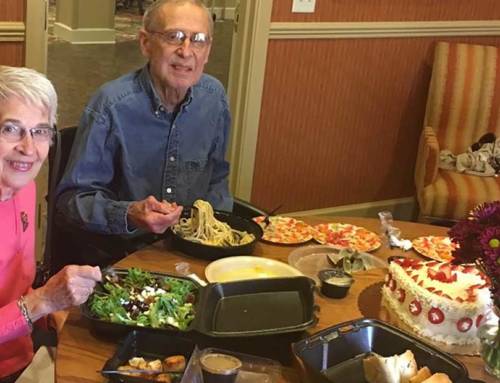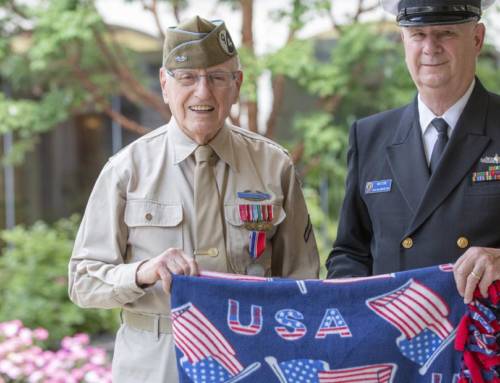Hugs, hand-holding and togetherness are all key elements in guiding patients and families through their hospice journey. For hospice caregivers across the country, COVID-19 replaced these crucial elements with masks, reduced physical contact and limited visits from family and friends.
“The virus has imposed, rightly and understandably, more barriers between ourselves and our patients that we have to strive to overcome,” Robert “Bob” Heim, hospice registered nurse, said. “Patients and families can’t see our reassuring smiles behind our masks, and that can be frightening.”
The Masonic Village Hospice team has come together and gotten creative during a trying time to continue to meet the physical and emotional needs of patients and their families.
“For many of my patients, this has been particularly hard,” certified nursing assistant Lori Henry said, “so I take extra time to make every one of my visits and interactions even more meaningful.”
Lori and many other hospice caregivers have been incorporating family phone calls and video chats into their regular visits.
For patients not receiving care at home, they can easily feel isolated.
“There is a sense of emotional distance and detachment,” Bob said. “It can be very hard to withhold a hug from the patient, or from family members during a loved one’s passing. We have to allow our tears to be seen and to express empathy and shared grief.”
In addition to emotional distance and detachment, those with advanced dementia can become fearful of care providers wearing masks, and patients with hearing loss can no longer rely on reading lips.
“We have to practice the art of smiling with our eyes and body language,” Bob said.
In order to protect patients and limit their exposure, hospice’s support services – including social workers, chaplains and bereavement staff – have been conducting visits via telehealth, phone calls and video chats.
“Nurses, nursing assistants and other caregivers have taken the time to help us coordinate telehealth visits,” social worker Jasmine Rakszawski said. “Our essential teammates are going above and beyond to care for patients physically, emotionally and spiritually.”
For those caring and advocating for patients and their families from a distance, the lack of in-person interaction has been a learning experience.
“We have team meetings over the phone to check in and support each other,” Jasmine said. “It’s been an uncertain time for all of us personally and professionally, so having the extra support, listening ears and regular check-ins have been meaningful to me.”
Caregivers, like Lori and Bob, have added new rituals in their home life, too.
“After work, I get out of my work clothes immediately and take a shower,” Bob said. “I have self-imposed some distancing at home. The last several months, I’ve been sleeping on the couch to protect both my family and my patients.”
“I use oodles and oodles of sanitizer,” Lori says. “I use my sanitizing spray on shoes, my bag – anything that I’m carrying with me to avoid exposing others.”
Regardless of the added stresses and precautions, Hospice staff continue to rise to the occasion.
“During this time, I have seen a real willingness to shift responsibilities – teammates moving into unfamiliar roles to see that all our patients’ and families’ needs continue to be met,” Bob said.
“I don’t know what else I’d want to be doing,” Lori said, “but helping people during a time like this.”
Challenges Faced by Grieving Families
Since the start of COVID-19, Heidi Young, bereavement coordinator, has gone from embracing someone after the loss of a loved one to being just a voice on the other end of the phone.
“For many, grief is already a difficult journey to navigate,” Heidi said. “It becomes even more difficult when someone must grieve alone in their home in the middle of a pandemic.”
During the earliest stages of grief, a person should be embracing their friends, family and community to form a support system. With the new limitations COVID-19 has placed on social interactions, Heidi encourages those who are grieving to reach out to Hospice for a phone call.
“Everything that I knew about helping people through grief went out the window,” Heidi said. “I’ve had to develop a new way of thinking and supporting families.”
Heidi encourages grieving families to stay connected with family and counselors through phone calls, video chats and online platforms. Setting a routine and staying busy with outdoor activities or favorite hobbies can also keep grief at bay. Journaling is also a good option.
“Our emotions and grief are raw right now,” Heidi said. “Capture and release those feelings by writing them down.”
Families whose loved ones pass away during the COVID-19 pandemic face unprecedented restrictions and challenges, including not being able to honor and celebrate a loved one by having a funeral with family.
“This has caused the normal healing process to be disrupted,” Heidi said.
“In a world where we’re in limbo and can’t be together, try to discover how you can best cope and grieve. Know you’re not alone, and take one day at a time until we are all together again.”




